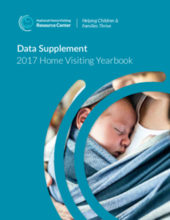The Data Supplement to the 2017 Home Visiting Yearbook presents 2016 data on early childhood home visiting, a proven service delivery strategy that helps children and families thrive.
It builds on the National Home Visiting Resource Center‘s inaugural Yearbook to present a more complete and up-to-date look at home visiting in action and to continue answering critical questions.
- Where do home visiting programs operate?
- How many families and children are being served by home visiting, and how many more could benefit?
- Who provides home visiting?
- What is happening in the states?
About Home Visiting
Home visiting connects parents-to-be and parents of young children with a designated support person who guides them through the early stages of raising a family. For many, it is a bridge to becoming the kind of parents they want to be so they can unlock their child’s potential. Home visiting is voluntary and tailored to meet families where they are—all at no cost to participants.
Data Supplement Highlights
- More than 300,000 families received evidence-based home visiting services in 2016 over the course of more than 3.8 million home visits.
- About 18 million pregnant women and families (including more than 23 million children) could benefit from home visiting but were not being reached in 2016.
- Evidence-based home visiting was implemented in all 50 states, the District of Columbia, 5 territories, 24 tribal communities, and 47 percent of U.S. counties in 2016.
- From 2010 to 2017, the federal Maternal, Infant, and Early Childhood Home Visiting Program (MIECHV) strengthened home visiting by supporting services, research, and local infrastructure. MIECHV expired in September 2017 but was reauthorized in February 2018 for 5 more years.
- In 2016, MIECHV helped fund services for 83,841 families in states, territories, and tribal organizations—a portion of the total families served by home visiting that year.
- States supported home visiting by combining funds from tobacco settlements and taxes, lotteries, and budget line items in 2016. With limited resources, states are continually working to expand the reach of home visiting to serve as many families as they can in ways that make sense at the local level.

